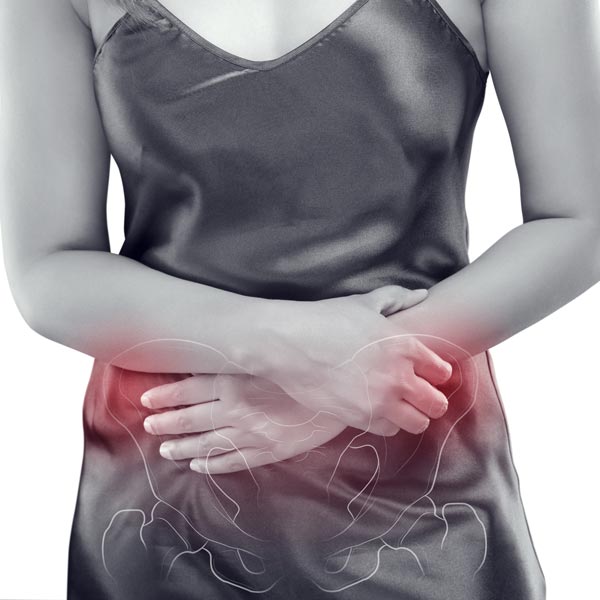6 Possible Causes of Pelvic Pain in Women

Pelvic pressure is an uncomfortable and often concerning experience, especially when the cause isn't immediately apparent. If you're feeling discomfort in your pelvic area, it's essential to know that you're not alone and more importantly, that you don't have to endure this pain without understanding why it’s happening or what you can do about it.
Why Should I Pay Attention to Pelvic Pressure?
The pelvic region is a sensitive body area that plays a crucial role in many aspects of your health. When something feels off, it can be easy to feel anxious or worried. It's not uncommon for people to downplay pelvic pain or dismiss it as just another part of life, but it's essential to take these symptoms seriously. Persistent or severe pelvic pain can impact your daily life—interfering with work, disrupting your ability to enjoy time with loved ones, and even affecting your overall well-being.
If you're experiencing pelvic pressure, trust your instincts. You know your body better than anyone, and it's okay to seek help if something feels wrong—even if it's just for peace of mind. If you’re not getting the answers or support from one healthcare provider, getting a second opinion is always okay. Discuss your concerns with your primary care provider or gynecologist and ask them to rule out common gynecological diagnoses like endometriosis, uterine fibroids, cysts, or infection before seeing a vascular specialist.
What Could Be Causing My Pelvic Pressure?
Pelvic Venous Insufficiency
Pelvic venous insufficiency (PVI) is a vascular condition that can cause pelvic pressure, particularly in women who have had multiple pregnancies. This condition occurs when the veins in the pelvic area do not drain blood properly, leading to a pressure buildup. While PVI is more common in women with multiple pregnancies, it can also affect others.
Several factors can increase the risk of developing PVI. Multiple pregnancies are a significant risk factor, with each pregnancy heightening the likelihood of experiencing PVI. Age is another factor, as PVI often develops during or after childbearing. Other factors, like a family history of chronic venous insufficiency or vascular disease, can increase the risk of pelvic insufficiency. Being overweight also contributes to the development of PVI, as excess weight can put additional strain on the veins in the pelvis and lower body.
If you are experiencing pelvic pressure and notice other symptoms such as chronic groin pain lasting over six months, discomfort during menstrual cycles, pain during or after sexual intercourse, a feeling of fullness or swelling in the pelvic region, or varicose veins appearing in the upper thigh, vagina, or perineal area, it is essential to consult a healthcare provider. These symptoms may indicate the presence of PVI, and discussing them with your doctor can help determine the best course of action.
Menstrual Cramps
Most people who menstruate are familiar with the cramping and discomfort that often accompany a period. While some levels of pain are average, it's crucial to recognize when your period pain might indicate a more serious issue. Menstrual cramps occur as the uterus contracts to shed its lining, and this pain is typically localized in the pelvic area, though it can also manifest in your lower back or cause headaches.
If your cramps progressively worsen or affect other areas of your body, discussing these changes with your doctor is essential. Menstrual cramps should not be so bad that they disrupt your life, cause you to miss out on daily activities, or lose sleep.
You should talk to your doctor if your menstrual cramps and pelvic pressure are becoming increasingly painful if you notice that you're bleeding more heavily than usual, or if the pain begins to radiate down your legs, as these could be signs of a more severe condition. A fever accompanying your cramps could indicate a severe problem, such as an infection. If your period pain is ever accompanied by chest pain or causes you to lose consciousness, seek immediate medical attention, as these symptoms could signal a critical condition.
Infections
Infections are another common cause of pelvic pressure. One of the most frequent infections in this area is a urinary tract infection (UTI). UTIs are known for causing painful urination and itching, but they can also lead to pelvic pain.
Other bacterial infections, such as those caused by Gardnerella or Staphylococcus, can also cause discomfort in the pelvic area. Even a yeast infection, usually characterized by itching, can sometimes result in pelvic pain. If you suspect an infection, it is essential to see a healthcare provider. They can confirm the infection and prescribe the appropriate treatment, usually antibiotics for bacterial infections or antifungal medication for yeast infections.
If you’re experiencing pelvic pressure, pain, and infection symptoms, make an appointment with your gynecologist or primary care doctor as soon as possible.
Endometriosis
Endometriosis is a condition where the tissue that usually lines the inside of your uterus begins to grow outside of it. Endometriosis can cause significant pain, especially during your period. Endometriosis is often accompanied by heavy bleeding, spotting between periods, and pain during bowel movements.
Although there's no cure for endometriosis, there are treatments available that can help manage the pain and other symptoms. If you suspect you might have endometriosis, it's important to discuss your symptoms with a healthcare provider, who can help guide you through the diagnostic process, which may include a physical exam and possibly surgery.
Pelvic Floor Weakness
Pelvic floor tension myalgia, also known as pelvic floor pain, occurs when the muscles in your pelvic floor become overly tight, leading to pressure or pain. Pelvic floor weakness can make it challenging to control these muscles, resulting in various symptoms such as difficulty with bowel movements, lower back pain, pain during sexual intercourse, and pain that changes depending on your body position.
While there is no guaranteed way to prevent pelvic floor pain, maintaining good posture and a healthy weight can help reduce the risk. Fortunately, physical therapy offers a promising path to recovery, with many people experiencing complete relief from the symptoms of pelvic floor tension myalgia.
Bartholin’s Cyst
The Bartholin's glands, located near the labia and vulva, are responsible for secreting fluid that helps lubricate the vagina. Usually, these glands are so small that you wouldn't even notice them, but if a duct becomes blocked, it can form a Bartholin's cyst, which is often uncomfortable.
While these cysts are often painless, they can sometimes become painful, especially if infected. Bartholin's cysts are more likely to occur in sexually active individuals in their 20s and 30s and are rare before puberty or after menopause.
If a Bartholin's cyst is causing you pain, consult a healthcare provider. Treatment can vary depending on the severity of the cyst, but options are available to help alleviate discomfort.
Should I See a Vascular Specialist About My Pelvic Pressure?
If you've been experiencing pelvic pressure for six months or more, have been experiencing painful intercourse, and have already spoken to your gynecologist or primary care doctor and ruled out conditions such as UTIs, endometriosis, or ovarian cysts, it might be time to see a vascular specialist. A vascular doctor can determine if your pelvic pressure is due to a vascular condition like pelvic venous insufficiency.
During your appointment, the specialist may use noninvasive ultrasound to assess the condition of your veins. If necessary, further testing with IVUS and venogram can confirm the diagnosis. Treatments, like placing a stent to open a vein, are minimally invasive and can offer significant relief from pressure or discomfort.
Pelvic Vascular Health Treatment at Center for Vascular Medicine
You deserve to live without chronic pain or discomfort, and that includes pelvic pressure. Don’t hesitate to contact a healthcare provider if you’re experiencing symptoms that concern you.
Whether it's a superficial infection or something more complex, treatments can help you feel better and get back to enjoying your life. Call (301) 486-4690 or book an appointment online at a Center for Vascular Medicine near you to get to the bottom of your pelvic pain.

